See also: Wonderful Variety; Pomegranate Tips & Usage;
Pomegranate Trivia POMEGRANATE HISTORY & TIMELINEPomegranate Timeline3500–2000 BC:
Based on excavations of the Early Bronze Age, it is believed that the pomegranate was one of the first cultivated fruits. Most scholars support the belief that the pomegranate was native to Iran and the Himalayas in Northern India, then cultivated over the whole Mediterranean region of Asia, Africa and Europe, migrating as far east as China where it has been cultivated since the pre-Christian era.
1600 BC:
The pomegranate was brought to Egypt from Syria during the rule of the Hyksos. Pomegranates were valued in Egypt as a food source and were part of the supply of fruits required in a pharaoh’s residence. Ancient Egyptians used the pomegranate in a variety of ways. The juice (called Schedou) was believed to fight intestinal worms, while the pomegranate blossom was crushed to make a red dye and the peel was used for dyeing leather. The pomegranate became so revered that representations of pomegranates were found on Egyptian wall paintings in tombs, symbolizing life after death. In fact, King Tut took a pomegranate vase into the afterlife with him. 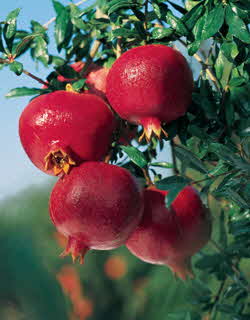
957 BC:
Solomon’s temple in Jerusalem was built. Pillars in the temple were decorated with pomegranates and the fruit was included on the robes of Jewish priests. The Torah describes the robes:
“And beneath upon the hem of it thou shalt make pomegranates of blue, and of purple, and of scarlet, round about the hem thereof; and bells of gold between them round about: a golden bell and a pomegranate, a golden bell and a pomegranate, upon the hem of the robe round about.” Exodus 28:33–34
Silver shekels minted in Jerusalem during the Jewish Great Revolt against Rome, which took place from 66 to 70 AD, depicted a branch with three pomegranates and a design element similar to that used in the Temple of Jerusalem.
700 BC:
Pomegranates were introduced to Rome via Carthage, its southern neighbor. Romans named the fruit Punicum malum, which translates as “Phoenician apple.” In Ancient Rome, pomegranates grew in shady areas of residential courtyards and were enjoyed as a summer fruit. Pomegranates were depicted in Roman mosaics, most notably in the House of the Fruit Orchard, located in Pompeii. Married women in Rome wore headdresses made of pomegranate twigs to signify their marital status. 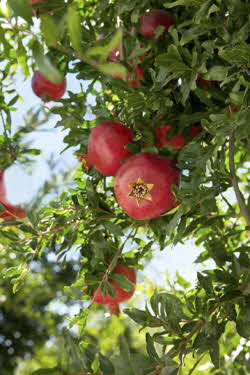
600–700 BC:
Zoroastrianism became the major religion of ancient Persia with the basic tenet that there is a constant battle between good and evil. Pomegranates were associated with fertility and seen as representative of the vegetable world, which provides man with food. Pomegranate trees were planted in the courtyards of Zoroastrian temples because their leaves, remaining green most of the year, stood as a symbol of eternal life.
563–483 BC:
It is believed that while the Buddha was camping in the kingdom of Bindusara, many of his wealthy disciples presented him with lavish gifts. Another of his disciples, an old, poor woman who had traveled many miles to see him, presented him with just one small pomegranate. The Buddha rang the bell of honor in her name, as he considered the pomegranate to be the greatest gift. In Buddhism, the pomegranate is one of the three blessed fruits and represents the essence of favorable influences in Buddhist art. 500 BC:
Pomegranates figured prominently in Greek myths; the most famous involved Persephone, daughter of Zeus and Demeter, who was abducted by Hades, Lord of the Underworld. Once there, Hades tempted her with a juicy pomegranate. By eating the arils, Persephone was thus joined to him – the pomegranate being a symbol of the indissolubility of marriage. Inconsolable at the loss of her daughter, Demeter, the corn goddess, prevented the earth from bearing fruit unless she saw her daughter again. Zeus arranged a compromise: Persephone would live with Hades for one third of the year and the other two thirds with Demeter. Persephone’s return from the Underworld each year is marked by the arrival of spring. 
485–465 BC:
Because the pomegranate is a symbol of strength in the Persian culture, the Persian army of Xerxes carried spears with pomegranates instead of spikes on the tip when they invaded Greece in 480 BC.
138–125 BC:
Pomegranates first came to China from the Middle East via the legendary Silk Road.
AD 50–85:
The completion and printing of the first bible included elements of the Torah, known as the Old Testament. The references to pomegranates remain intact, including the passage: “Let us go early to the vineyards to see... if the pomegranates are in bloom—there I will give you my love.” Song of Solomon 7:12
AD 520:
Bodhidharma, an Indian monk and meditation master, arrived in China where he founded Zen, a school of Buddhism. After the Buddha, it is Bodhidharma who was most significant in giving Zen its distinctive character. Pomegranates, among other things, decorate the Temple of the Founder of Zen, which was built in 1195 in China to honor Bodhidharma. AD 609–632:
Muhammad, the prophet whose visions laid the foundation of Islam, considered the pomegranate to be a precious fruit filled with nutrition, bringing both emotional and physical peace. Legend has it that each pomegranate contains one aril descended directly from paradise.
AD 1238–1358:
During the Islamic Nasrid Dynasty, the Moors built the Alhambra in Granada, Spain, an immense palace and fortress that also contained a mosque, bath, royal residential quarters and courtrooms. Throughout the massive and beautifully crafted structure, pomegranates are depicted in the intricate archway designs and mosaics. 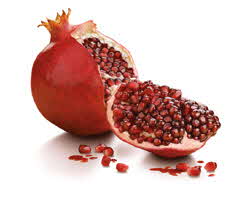
AD 1480–1502:
The pomegranate emerged in Christian art as a symbol of Christ’s resurrection and promise of life after death. In paintings by Sandro Botticelli, Raphael and Filippino Lippi, the Virgin Mary appears with the infant Christ and a pomegranate. A symbol of Jesus’s resurrection and life everlasting, the pomegranate represents plenitude, hope, spiritual fruitfulness and the Virgin Mary’s chastity. The Virgin Mary has also been likened to a pomegranate tree filled with sweetness because, like the enclosed seeds of a pomegranate, she is said to contain within her many benefits for mankind, all revealed in the form of Christ.
AD 1492:
Queen Isabella and King Ferdinand ended the Reconquista of Spain when they conquered Granada, the last Muslim stronghold of Andalusia. According to local lore, Queen Isabella stood with a pomegranate in her hand and declared, “Just like the pomegranate, I will take over Andalusia seed by seed.” The pomegranate is not only the city’s namesake, the fruit is included in its coat of arms to this day.
AD 1509–1547:
The pomegranate figured prominently during the early reign of King Henry VIII of England when he was married to Catherine of Aragon, daughter of Queen Isabella and King Ferdinand. To represent this union Henry had the couple’s emblems – the pomegranate of Granada, the arrow-sheaf of Aragon, and the Tudor Rose – merged together adorning every royal palace. Gilded pomegranates were used during the festivities surrounding the wedding ceremony and the Queen’s coronation. It is also said that Henry planted the first pomegranate tree in Britain.
AD 1519:
Maximilian I of Austria, Holy Roman Emperor, was depicted in Albrecht Dürer’s 1519 portrait holding a pomegranate in the same way that a monarch holds an orb during his coronation. During his reign, Maximilian adopted the pomegranate as his personal emblem. 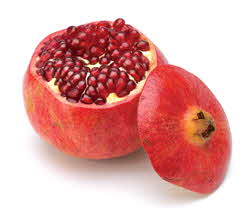
AD 1521:
After Spanish conquistador Hernándo Cortés conquered the Aztecs in Mexico, Spanish missionaries planted the first pomegranate trees in the New World. From Mexico, the pomegranate was transported north to missions in California and Texas.
AD 1522–1562:
Eleonora di Toledo, wife of Cosimo I de Medici, Duke of Florence and the first Grand Duke of Tuscany, was depicted in several paintings wearing a dress that prominently displays a pomegranate design. Having given birth to seven sons, ensuring the continued line of the ruling Medici family, she used the pomegranate to symbolize her valued role as a mother.
AD 1598:
King Henry IV of France passed the Edict of Nantes, which granted religious freedom and ended the violent civil war between Catholics and Protestants. To represent his reign, he chose the pomegranate as his heraldic badge, with the motto “sour, yet sweet,” comparing the nature of the fruit with his belief that a king should temper severity with mildness.
AD 1735:
Carl Linnaeus, a Swedish botanist called “The Father of Taxonomy” (the science of classifying living things), gave the pomegranate its botanical name, Punica granatum. The botanical name is similar to the pomegranate’s original Roman name Punicum malum. 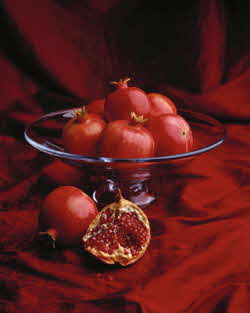
AD 1792:
In his journal, Voyage of Discovery, British explorer George Vancouver, the first Englishman to visit Spanish California, noted the abundance of pomegranate trees at Mission San Buenaventura in Ventura, California. The prevalence of the fruit is also reflected in a pomegranate-themed fresco decorating the interior of the Mission San Miguel Arcangel.
AD 1793:
During the French Revolution, the government created a new Republican calendar and commissioned artist Louis Lafitte to provide illustrations representing each month as an allegorical female figure. For the twelfth month of the year, Fructidor (August/September), Lafitte portrayed the Virgo virgin with an open pomegranate, possibly as an allusion to the pomegranate’s association with chastity, fruitfulness and harvest.
AD 1896:
A Porterville farmer named Mr. Bearss brought pomegranate cuttings from Florida to California and began propagating them. This variety was sweeter and juicier than the others, so he aptly named it the Wonderful variety.
AD 1900–1952:
Pomegranates were part of modern artistic movements such as Post-Impressionism, Fauvism, Cubism and Surrealism. Paul Cézanne, Henri Matisse, Pablo Picasso and Salvador Dalí all depicted pomegranates in their work.
AD 2000:
More than 100 years after the Wonderful variety was first propagated in California, consumers rediscovered this ancient fruit as pomegranates became widely available for the first time across the United States. Pomegranates are embraced for their sweet taste, plentiful juice, health benefits and culinary versatility. For additional information visit: POM Wonderful
| 